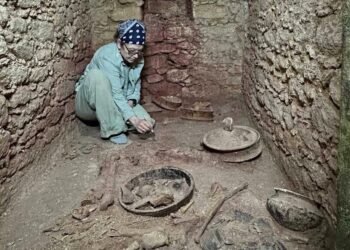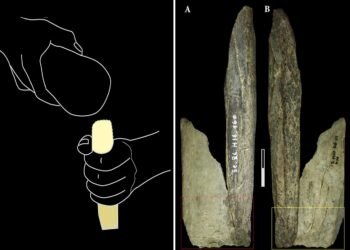Archaeologists have unearthed a tomb dating back to the Tang Dynasty (618-907 CE) in China’s Shanxi Province. The discovery, made during construction activities in Taiyuan in 2018, has revealed a treasure trove of well-preserved murals.

The tomb, which dates to the 8th century CE, features vibrant murals painted in a spectrum of colors, including white, red, yellow, black, green, and orange. These murals cover every surface of the tomb except for the floor, showcasing scenes of daily life, mythological creatures, and artistic motifs typical of the Tang Dynasty. The excavation has been led by the Shanxi Provincial Institute of Archaeology, which has meticulously studied the site since its discovery.
The tomb’s entrance is adorned with swirling botanical designs in red and yellow-orange hues. A pair of robed figures believed to be guardians are depicted on either side of the tomb door. Similar guardian figures are painted along the corridor leading to the main burial chamber. Inside the chamber, the conical ceiling features fantastical beasts such as dragons, outlined by thick red ribbons and floral patterns on a white background. The walls are decorated with rectangular panels outlined in red, depicting individuals in various postures and activities under stylized trees, a popular Tang-era style known as “figure under the tree.”
The murals provide a rich portrayal of daily life during the Tang Dynasty. One panel on the east wall features multiple scenes: a man rolling a stone grinder to peel grain shells, a woman working a stone mill, a man making dough balls with an iron pan on fire, another man using a rice pounding tool, a woman drawing water from a well with a counterweight device, and a woman doing laundry in a basin.
Another significant mural on the west wall depicts a woman in a multicolored gown holding a box, accompanied by a man from a non-Han ethnic group, holding the reins of camels and horses. This depiction is particularly notable as camels, though not native to China, frequently appear in Chinese tomb art and sculptures, highlighting the influence of the Silk Road and cultural exchanges during the Tang era.
Long Zhen, the director of the Jinyang Ancient City Archaeological Institute, has drawn parallels between these murals and those found in the tomb of Wang Shenzi, who founded the dynastic state of Min (909-945) during the Ten Kingdoms period. The artistic style of the murals in the newly discovered tomb in Taiyuan is strikingly similar to that in Wang Shenzi’s tomb. It is possible that the same artist created both sets of murals.
The tomb’s discovery adds significant knowledge to our understanding of Tang Dynasty art and daily life. The “figure under the tree” style, characterized by strong outlines and simple shading, gives the murals a two-dimensional appearance that was prevalent in Taiyuan, the capital of Shanxi province, during the Tang period. This style contrasts with the more three-dimensional and intricate murals found in the Mogao Grottoes of Dunhuang, another significant site along the Silk Road.
























